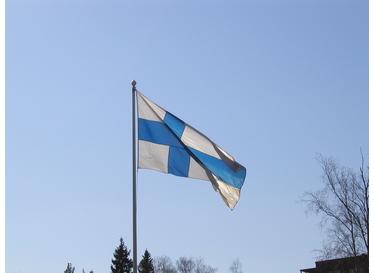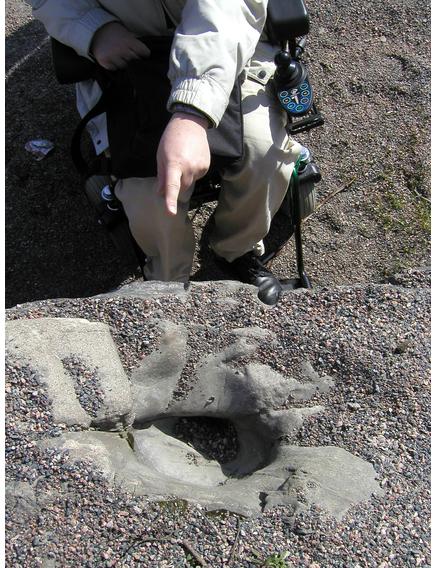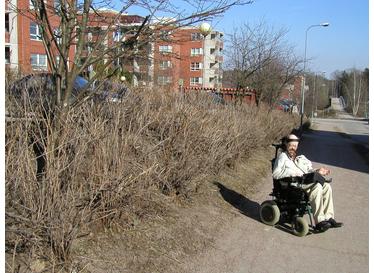 Pitkäperjantai
PitkäperjantaiPääsiäisessä on vaikka kuinka paljon erilaisia juttuja. Kaikki alkaa laskiaisena. Sitten varsinainen pääsiäinen alkaa Palmusunnuntaina.
There are really many things containing to the Easter. Actually, that's really highly religious thing. But not anymore, now the whole thing is very secular. 40 days before is Shrovetide (actually Carnival). The real Easter starts with Palm Sunday.
 Pitkäperjantai
PitkäperjantaiPitkäperjantaina kävimme kävelyllä. Tai eihän sähkärillä kulkemista voi ihmeemmin kävelyksi kutsua!
Niin, tämä oli myös Mikael Agricolan (1510-1557) päivä (ja tähän on nimenomaan hänen kuolinpäivänsä, syntymäpäivää ei taideta oikein tietää). Siis lähinnä suomenkielen päivä. Tänään palkitaan nimenomaan kääntäjiä: sitähän Agricolakin oikeastaan oli. Samalla tuli tosin luotua kirjoitusasu kielelle (joitain omituisuuksia on, esimerkiksi sana "jalopeura" (eihän leijona muistuta vähääkään hirveä, joku "turboahdettu ilves" olisi sopivampaa)).
I was "on walk" this day. Though one can't call it that with electric wheelchair. But anyway...
This is the day of Mikael Agricola (1510-1557). He was the father of our written language. Naturally this language was spoken. But not written. Because there were just no books! Agricola solved this problem. First was simply ABC-book: "ABC kiria" 1543. Then (as he was a bishop or at least a priest) some kind of book of payers: "Rucouskiria" 1544.
The biggest thing was really bible (because he was a bishop after all). But only The New Testament: "Se Wsi Testamenti" 1548.
Of course those books contained flaws. Because he used dialect
spoken there. That isn't really understandably everywhere! And
he had to "invent" new words. Some inventions were really
excellent, in use still now. Some weren't so good... But he made
beginning!
 Kääntöpaikalla
oli pikkuinen hiidenkirnu! Eihän tuo mikään iso
ole (voisi sanoa, että kattilan kokoinen), mutta yhtäkaikki.
Kääntöpaikalla
oli pikkuinen hiidenkirnu! Eihän tuo mikään iso
ole (voisi sanoa, että kattilan kokoinen), mutta yhtäkaikki.
Sehän on muodostunut viimeisimmän jääkauden sulamisen aikoihin. Sulamisvedet ovat pyöritelleet jotain kivenmurikkaa kallionkolossa. Ja siinä tuo on hioutunut (kilometri jäätä on tuottanut kohtuullisen määrän sulamisvettä).
We had ice-age! And there is very concrete proof of it:a giant's kettle. Okay, that isn't any big one (I could use kettle of that size).
It's located nearly on border between Espoo and Helsinki. On Espoo side, but only very barely.
This pothole is made by melting waters of that huge continental glacier. Some rock (not very big in this case, maybe incher or a little bigger) in in a nice hole of rather big rock.
Then water moved it. And it grinds a little. But there are
really huge amounts of water...
 Etelärinnekin
on vielä täysin ilman kasveja (eikä mitään
karkkipapereita tuhoavaa ole myöskään). Päivällä
lämpö kyllä nousi reilusti yli kymmenen asteen,
mutta yöllä oli pakkasta useampia asteita. Siinä
ei vielä mikään pysty elämään.
Etelärinnekin
on vielä täysin ilman kasveja (eikä mitään
karkkipapereita tuhoavaa ole myöskään). Päivällä
lämpö kyllä nousi reilusti yli kymmenen asteen,
mutta yöllä oli pakkasta useampia asteita. Siinä
ei vielä mikään pysty elämään.
Minulla on kuva samasta paikasta kesällä.
This is the warmest possible place here: this bank faces south. And this place is really quite warm now: something like +10C (or even a bit more). But nothing green. Actually that's easy thing to explain: nights. Then the temperature goes down; a lot below freezing-point. Okay, some creatures can tolerate rather cold temperatures. But not this cold!
So, every possible candy-paper (or dog-shit (but that's really excellent fertilizer then)) is there. Because maggots can't do anything.
Same place in summer.
Oikeastaan vain 1 pääsiäispäivä on oleellinen. 2 on lähinnä ammattiyhdistysten hupia.
First day of Easter is significant. Second is just nothing. Though it makes a very long weekend.